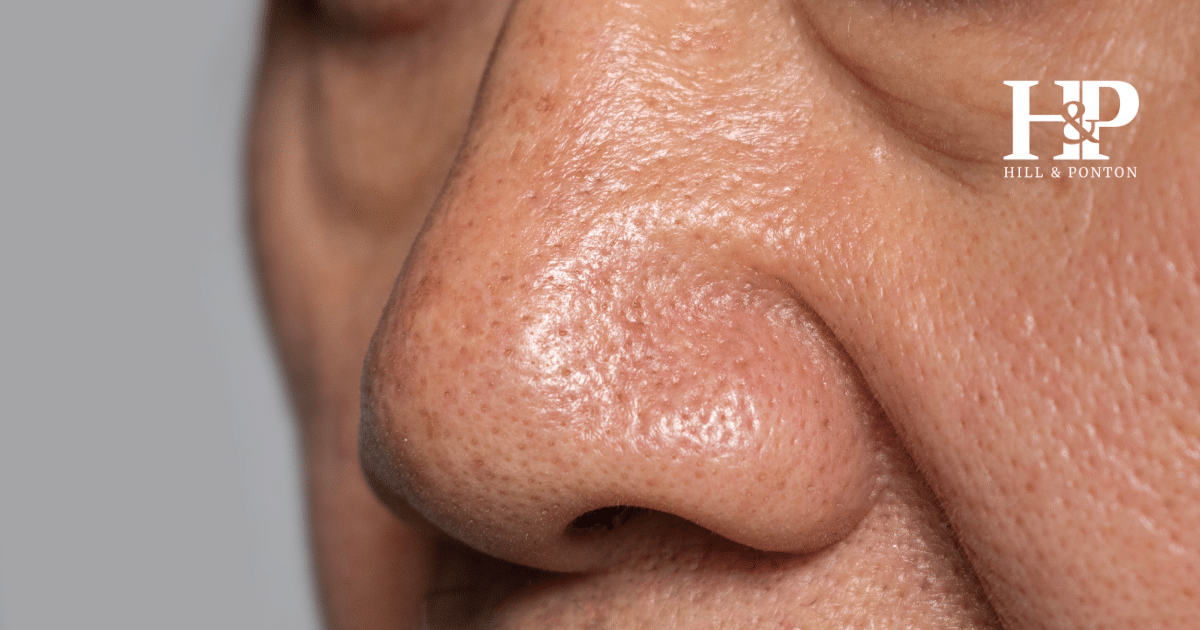A deviated septum can sometimes be a significant concern for veterans, specifically those who may have suffered facial injuries during their military service.
Understanding how the VA both evaluates and rates this condition for disability benefits is important for obtaining compensation.
This article will detail what a deviated septum is, how to get it service-connected, what you can expect at a C&P examination and answer other frequently asked questions by veterans concerning obtaining VA benefits for this condition.
Can I Claim Disability for a Deviated Septum?
Deviated septums can be congenital (occur during birth) or traumatic and caused by:
- Blows to the face from combat or training incidents
- Accidents during physical training or recreational activities
- Medical procedures or surgeries involving the nasal passage
Symptoms and Impacts on Daily Life
Deviated septums can cause a wide variety of symptoms that can impact a veteran’s life in various ways and degrees. Below are some of the most common that can be used in a claim for this disability or for secondary conditions.
- Blocked Nasal Cavity: Difficulty breathing through one or both nostrils
- Breathing Difficulties: Compromised airflow can make breathing especially difficult, further compounded by activities like exercise or sleeping
- Snoring: Obstructed airflow often leads to snoring or sleep disturbances
- Recurring Nosebleeds: The uneven airflow can dry out the nasal membranes, causing frequent nosebleeds
- Facial Pain: The strain of breathing through a blocked nasal passage can lead to facial pain and headaches.
- Reduced Sense of Smell: Severe deviation can impact the ability to smell
- Postnasal Drip: Mucus build-up can cause a drip down the throat, leading to irritation and coughing
How Do I Prove my Deviated Septum is Service-Connected?
To receive VA disability benefits you must be able to prove that your condition is connected to your time in military service. Here’s what you’ll need to establish this connection, either directly or as a secondary condition.
Direct Service Connection
- Current Medical Diagnosis: You must have a current diagnosis of a deviated septum from a medical professional. This is the foundation of your entire claim.
- In-Service Event, Injury or Disease: You need to show that an event that occurred while you were serving caused or worsened your deviated septum. This could be anything from an injury during combat, training accidents, etc.
- Nexus (Link) Between Service and Condition: You must also establish a direct link (also called a nexus) between your military service and your deviated septum. This is often done through a Nexus Letter written by a medical professional who states it’s “more likely than not” that your condition is related to your time in service.
Secondary Service Connection
If your deviated nasal septum has caused additional medical concerns, you may be able to claim them as secondary conditions. Chronic Sinusitis and Sleep Apnea are two examples, among others.
Like establishing direct service connection, you will need medical records showing the connection and a medical opinion linking the secondary condition to your service-connected deviated septum.
For more information on how to obtain a higher rating through secondary conditions, please continue reading below.
What is the VA Disability Rating for Deviated Septum?
The VA will evaluate and rate disabilities based on how much they impact a veteran’s ability to function in daily life.
For a deviated septum, the VA uses specific criteria to determine the disability rating, which will impact the amount of compensation a veteran can receive.
10% Disability Rating: This is the only rating available for a deviated septum. To qualify, your condition must meet the following criteria:
- 50% Obstruction of Nasal Passages on Both Sides: This means that at least half of the nasal passages on both sides are blocked, OR
- Complete Obstruction on One Side: Alternatively, if one side of your nasal passage is entirely blocked, you can also qualify for this rating.
By meeting the criteria above, you can receive a 10% rating for your deviated septum, however it is essential to remember you may be eligible for higher compensation if your deviated septum leads to other related conditions.
How to Get a Higher Rating
While the VA will only provide a 10% disability rating for a deviated septum alone, most veterans file for multiple disabilities simultaneously to increase the chances of a higher rating, and you may be eligible for a higher combined rating if your deviated septum leads to other conditions.
These secondary conditions can significantly impact your overall health and qualify you for additional compensation as a result.
Common Secondary Conditions Related to Deviated Septum
The two most common secondary conditions related to deviated septums are Chronic Sinusitis (rated at 50% VA disability at the highest rating) and Sleep Apnea (rated at 100% VA disability at the highest rating).
- Chronic Sinusitis: characterized by prolonged inflammation and swelling of the sinus cavities, often leading to breathing difficulties, facial pain and recurring infections.
- Sleep Apnea: a disorder where breathing repeatedly stops and starts during sleep, often leading to daytime fatigue and other health complications.
By proving your deviated septum has led to other significant health issues, you can potentially qualify for a higher combined disability rating. This increased rating can provide better compensation and support for managing your conditions.
Did the VA Deny Your Disability Claim?
Let our team review your case today!
Get a Free Case EvaluationWhat If I Was Born with a Deviated Septum?
If you were born with a deviated septum, you may still qualify for VA disability benefits. The important factor here is that you are able to demonstrate how your military service aggravated the condition (made it worse).
How Do I Prove Aggravation?
- Medical Evidence: Obtain any medical records that can show the condition existed prior to your service, but was stable or asymptomatic.
- In-Service Aggravation: Provide evidence that military service did in fact worsen your condition. This can be anything from medical records documenting things like facial injuries or another event that could have exacerbated the deviated septum.
- Nexus Letter: Secure a Nexus Letter from a medical professional who can state that they believe your military service did aggravate your pre-existing condition.
By demonstrating your deviated septum worsened during your time in service, you can still potentially establish a connection and receive VA disability benefits as a result.
What Happens During a C&P Exam for a Deviated Septum?
A Compensation and Pension (C&P) exam is an important step in a VA disability claim. It not only evaluates the severity of your condition and how it impacts your day-to-day life, but also determines its connection to your military service.
Here’s some tips to make sure you have a successful outcome:
Gather All Documentation and Keep a Symptom Diary
Make sure you have all relevant medical records (including your diagnosis and treatment history), and any other evidence linking your condition to service with you.
Additionally, maintaining a log of your symptoms (noting frequency, severity and impact on your life) can be useful for a medical examiner to understand more about your deviated septum.
Confirm the Details and the Severity of Symptoms
During the exam, the medical examiner should confirm your diagnosis and the details surrounding it (when you were diagnosed, the cause of the deviated septum, etc).
Additionally, they should assess any breathing difficulties, nasal passage obstructions, snoring issues, nosebleeds, and other related symptoms, as well as treatment history.
You may also be asked to talk about your quality of life as a result of the aforementioned symptoms, and how your condition impacts your ability to work or perform daily tasks.
After the exam, a report will be compiled that details all of the information that was discussed.
This report will be sent to the VA for consideration in your disability claim, and you can request a copy of the report if you need it for any reason.
Is the VA Rating for Deviated Septum Permanent?
The VA rating for a deviated septum may not be permanent.
Since a deviated septum can be treated with surgery, the VA might initially grant a temporary rating, meaning if your symptoms significantly improve after treatment, they may reduce or remove your rating.
If surgery is not an option or can’t alleviate the symptoms, your rating could remain the same.
Factors Affecting Permanency of a VA Rating for Deviated Septum
- Medical Treatment: Discuss with your doctor whether surgery or other treatments are recommended for your condition.
- Ongoing Symptoms: Keep detailed records of your symptoms, especially if they worsen over time. This information can be very important if the VA re-evaluates your condition.
- Periodic Re-Evaluations: If the VA does review your condition to determine if there have been any changes, it’s important to document worsening symptoms or additional related conditions that may develop.
Understanding the VA disability ratings for a deviated septum, and the criteria and evidence required of you to have a successful claim, can significantly boost your chances of receiving the benefits you deserve. Remember, the process can seem daunting, but the right preparation and support can make a substantial difference.
For more information about the VA disability claim, tips and tricks from our legal team, and additional content you won’t find elsewhere, subscribe to our weekly newsletter.
Join Thousands of Veterans!
Get the weekly newsletter that has helped veterans all over the country in the fight for their rightful benefits
join for free



